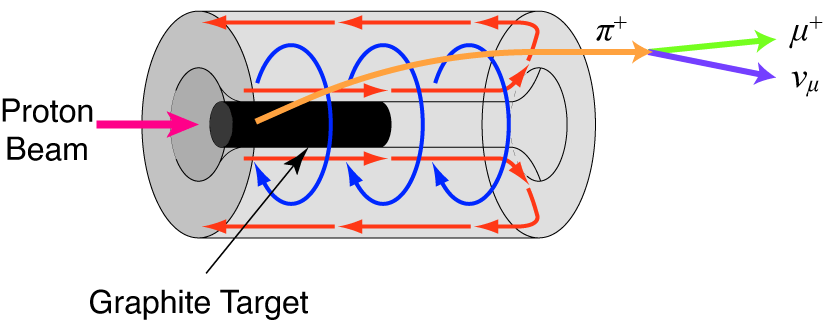Production of Anti-Neutrino Beam
In the T2K experiment conducted at the J-PARC High Intensity Proton Accelerator Facility, since its inception, we have continuously sent muon neutrino beams to the Super-Kamiokande detector located 295 km away. In July 2014, we achieved the discovery of oscillation from muon neutrinos to electron neutrinos (νμ → νe ) through the electron neutrino appearance. The next phase of the T2K experiment involves studying the measurement of anti-neutrino oscillation phenomena, and to that end, J-PARC has started the generation of anti-muon neutrino beams.
A muon anti-neutrino (νμ) is the antiparticle of a muon neutrino, generated at J-PARC through the decay of negative pions as follows:
π− → μ− + νμ
Protons accelerated up to 30 GeV in the Main Ring are directed into the neutrino beamline, colliding with a graphite target to generate numerous secondary particles, mainly being comprised of pions. The graphite target is positioned at the center axis of a specialized electromagnetic device called a horn magnet (Figure 1). The horn magnet has a structure resembling two concentric aluminum alloy cylinders joined at the front, with current flowing between the two layers as indicated by the red arrows in the figure. This creates a toroidal magnetic field around the central axis in the direction of the blue arrows in the figure. Due to this magnetic field, in the case of Figure 2, positively charged pions originating from the target are focused in the forward direction. Neutrinos, being electrically neutral, cannot be focused by the magnetic field directly, so an indirect method is employed by focusing the pions before their decay. Conversely, negatively charged pions are pushed outward, resulting in mostly νμ being directed towards Super-Kamiokande. Notably, generating the required magnetic field intensity for pion focusing necessitates a current of 250 kA, which is achieved by pulsing the current synchronized with the beam as passing such a high electric current continuously is impractical. At this moment, we hear a loud bang from the horn magnet.
Since neutrino focusing is based on the above principle, reversing the direction of the current in the horn magnet also reverses the toroidal magnetic field, allowing focus of negatively charged pions, and dominantly directing νμ towards Super-Kamiokande. Using this method, J-PARC started the operation of anti-muon neutrino beams in June 2014, confirming the extraction of anti-neutrino beams with a quality comparable to neutrino beams as a result of checks on beam direction, intensity, and profile. As shown in Figure 3, Super-Kamiokande also observed anti-neutrino reaction events, and data accumulation is progressing smoothly.
The primary purpose of measuring oscillation phenomena with anti-neutrino beams is to measure the CP phase angle δCP of neutrinos and discover CP symmetry breaking in the lepton sector. The theoretical formula representing the probability of oscillation from muon neutrinos to electron neutrinos, P(νμ→νe), contains a term involving sin δCP, with this term taking opposite signs for neutrino and anti-neutrino oscillations. Therefore, by determining the asymmetry between neutrino and anti-neutrino oscillation probabilities as follows:
\begin{align*}
A_{CP} = \frac{P(\nu_{\mu} \rightarrow \nu_e) – P(\bar{\nu}_{\mu} \rightarrow \bar{\nu}_e)}{P(\nu_{\mu} \rightarrow \nu_e) + P(\bar{\nu}_{\mu} \rightarrow \bar{\nu}_e)} ,
\end{align*}
the sin δCP term can be extracted. The value of δCP has yet to be measured, and the T2K experiment aims to be among the first to measure this value globally. If this value is non-zero, it would demonstrate the existence of CP symmetry breaking in the lepton sector.
In the world of particle physics, when particles are created, their antiparticles are simultaneously generated. Therefore, even at the Big Bang, considered the beginning of the universe, it is believed that an equal number of particles and antiparticles were produced. However, observing the current universe, there is no antimatter consisting of antiparticles, and everything seems to be made up of matter only. This discrepancy is one of the biggest mysteries in the modern physics. To reveal this mystery, significant CP symmetry breaking is required, yet the measured CP symmetry breaking in the quark sector is too small to explain the current universe. Hence, considerable expectations are placed on CP symmetry breaking in the lepton sector. Although its value is unknown until the measurement, it may resolve the matter-antimatter asymmetry mystery as anticipated. Alternatively, it might demand even greater CP asymmetry, necessitating unknown physics. In any case, measuring CP asymmetry in the lepton sector will undoubtedly advance research into revealing the mysteries of the universe.



